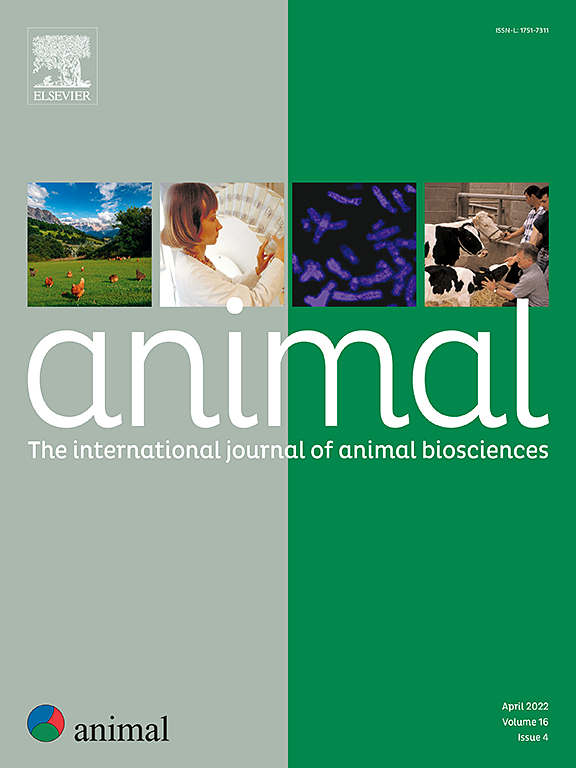成年亚群降低动物蛋白比例以满足营养需求的环境权衡
IF 4
2区 农林科学
Q1 AGRICULTURE, DAIRY & ANIMAL SCIENCE
引用次数: 0
摘要
建议减少动物性食物所占的蛋白质份额,以实现更可持续和更健康的饮食。本研究旨在评估低动物蛋白饮食对环境的潜在影响。饲料模型包括动物蛋白在总蛋白中满足营养需求且不增加成本的最低份额。新的饮食还减少了与观察(OBS)饮食在食物数量上的差异。他们用数学优化的方法为5个成年亚群(按性别和年龄定义)建模。该模型是通过结合INCA2数据库(对法国人口的OBS饮食进行建模)和207种食品的数据库来调整营养和价格参数而创建的。所有模型饮食均满足营养和成本限制。为每个亚群确定低动物蛋白(LAP)饮食,逐步减少动物蛋白的份额,每次减少5%,直到蛋白质的推荐量和/或消费限制不再满足。利用Agribalyse®3.0的生命周期评估和生命周期清单,计算了LAP饲粮在8个影响类别中的潜在环境影响。整个种群的LAP饮食以亚种群LAP饮食的加权平均值计算。动物蛋白的比例从OBS日粮的70%下降到LAP日粮的50%。与OBS日粮相比,LAP日粮减少了5项环境影响:气候变化(温室气体排放)、酸化(酸化化合物排放)和土地占用(均减少30%以上)、累积能源需求(减少23%)和海洋富营养化(减少13%)。相反,它增加了三个环境影响:淡水富营养化和用水(两者都增加了约40%)和生物多样性破坏潜力(与土地利用相关的物种潜在损失)(增加了66%)。这些结果表明,将动物蛋白的比例降低到50%是符合营养需求、可负担性和消费限制的,但对环境的影响是复杂的。本文章由计算机程序翻译,如有差异,请以英文原文为准。
Environmental trade-offs of meeting nutritional requirements with a lower share of animal protein for adult subpopulations
Decreasing the share of protein contributed by animal-based foods is recommended to move towards more sustainable and healthier diets. This study aimed to assess the potential environmental impacts of diets with a lower share of animal protein. The diets were modeled to include the minimum share of animal protein in total protein that met nutrient requirements and did not increase costs. The new diets also minimized the difference in the quantity of food from those of observed (OBS) diets. They were modeled for five adult subpopulations (defined by sex and age) using mathematical optimization. The model was created by combining the INCA2 database (to model OBS diets in the French population) and a database of 207 food items to adjust nutritional and price parameters. All modeled diets satisfied nutritional and cost constraints. A low-animal-protein (LAP) diet was identified for each subpopulation by progressively decreasing the share of animal protein by steps of 5% until the recommended quantity of protein and/or consumption constraints were no longer satisfied. Potential environmental impacts of the LAP diets in eight impact categories were calculated using life cycle assessment and life cycle inventories from Agribalyse® 3.0. A LAP diet for the entire population was calculated as a weighted mean of the subpopulations’ LAP diets. The share of animal protein decreased from 70% in the OBS diet to 50% in the LAP diet. Compared to the OBS diet, the LAP diet decreased five environmental impacts: climate change (greenhouse gas emissions), acidification (emissions of acidifying compounds) and land occupation (all by more than 30%), cumulative energy demand (by 23%) and marine eutrophication (by 13%). Conversely, it increased three environmental impacts: freshwater eutrophication and water use (both by ca. 40%) and biodiversity damage potential (potential loss of species associated with land use) (by 66%). These results suggest that decreasing the share of animal protein to 50% is compatible with nutritional requirements, affordability and consumption constraints, but would have mixed effects on the environment.
求助全文
通过发布文献求助,成功后即可免费获取论文全文。
去求助
来源期刊

Animal
农林科学-奶制品与动物科学
CiteScore
7.50
自引率
2.80%
发文量
246
审稿时长
3 months
期刊介绍:
Editorial board
animal attracts the best research in animal biology and animal systems from across the spectrum of the agricultural, biomedical, and environmental sciences. It is the central element in an exciting collaboration between the British Society of Animal Science (BSAS), Institut National de la Recherche Agronomique (INRA) and the European Federation of Animal Science (EAAP) and represents a merging of three scientific journals: Animal Science; Animal Research; Reproduction, Nutrition, Development. animal publishes original cutting-edge research, ''hot'' topics and horizon-scanning reviews on animal-related aspects of the life sciences at the molecular, cellular, organ, whole animal and production system levels. The main subject areas include: breeding and genetics; nutrition; physiology and functional biology of systems; behaviour, health and welfare; farming systems, environmental impact and climate change; product quality, human health and well-being. Animal models and papers dealing with the integration of research between these topics and their impact on the environment and people are particularly welcome.
 求助内容:
求助内容: 应助结果提醒方式:
应助结果提醒方式:


